How to care for a peace lily – an expert guide to getting the most out of these beautiful houseplants
Keep your indoor peace lily plant healthy and looking good with our expert guide for beginners
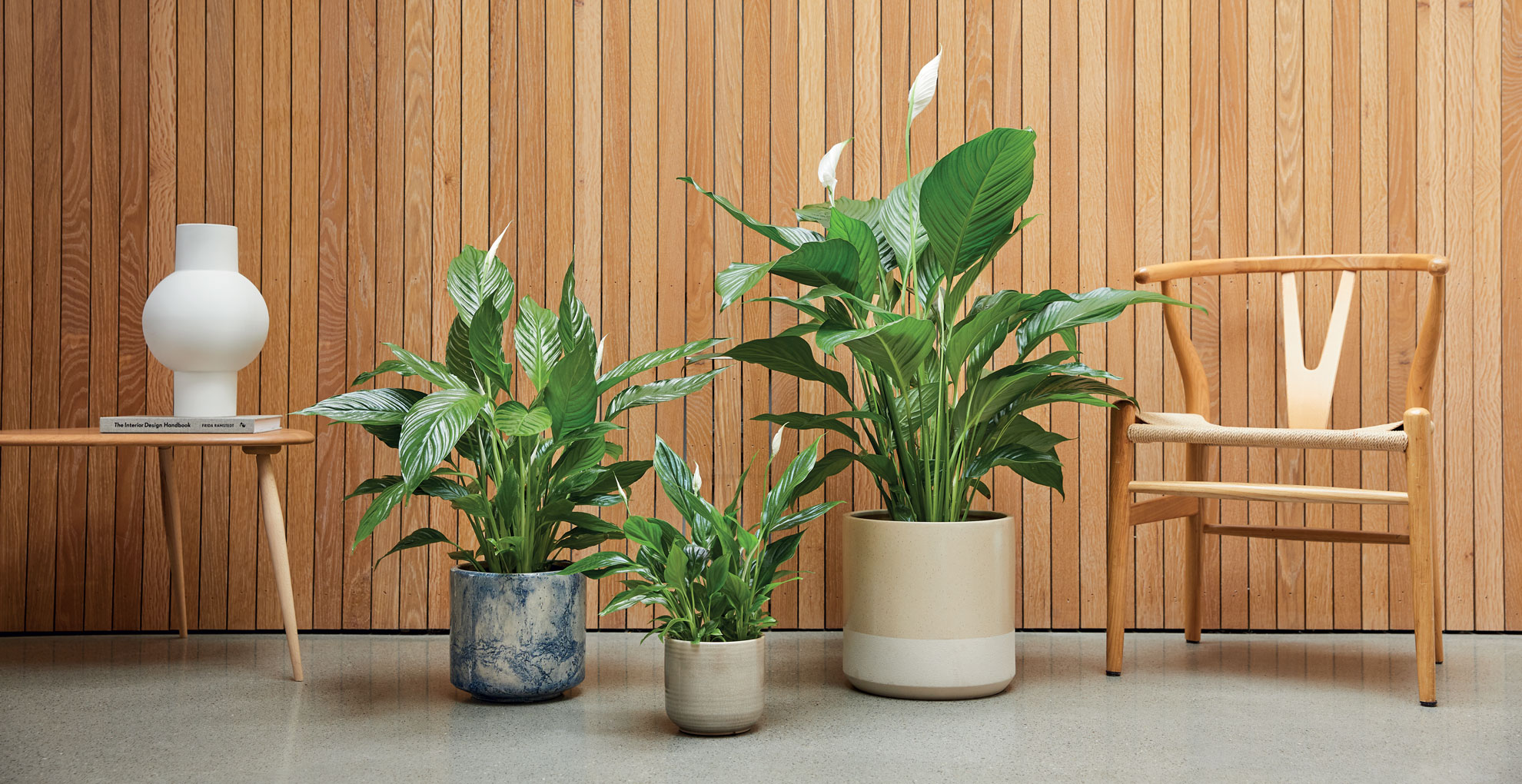

Find out how to care for a peace lily correctly and these beauties will reward you by flourishing in your home. If you're a new plant parent put it at the top of your houseplant wish list for its easy-care nature and elegant good looks.
The easy-going peace lily is a fabulous starter houseplant if you're a newbie. It might not make the list of the most fragrant houseplants to make your house smell good but it is one of the best indoor plants for health and wellbeing.
After all, there aren’t many houseplants that bloom happily in low light levels either or have the ability to act like one of the best air purifiers by removing pollutants. This makes them a must-have for your new plant collection.
Even though the peace lily is low maintenance and super easy to cultivate, you'll still want to make sure you max up your plant’s potential and prevent your peace lily tips turning brown by following our expert tips on how to care for a peace lily.
How to care for a peace lily: 6 easy steps
The peace lily is an elegant and popular choice for indoor flowering plants, bringing a touch of tranquillity to any space.
"With beautiful, white flowers and a calming ambience, the peace lily is a gorgeous houseplant to add to your collection," says Jo Lambell, founder of houseplant specialists Beards & Daisies.
"You’d be forgiven for thinking it may be difficult to care for, judging by its stunning appearance, however, it's very low maintenance and also a fantastic air purifier. According to the ancient art of feng shui, peace lilies can cleanse the energy of a room, bringing peace and tranquillity to your home." And it's not nearly as tricky as mastering how to care for an orchid.
Sign up to our free daily email for the latest royal and entertainment news, interesting opinion, expert advice on styling and beauty trends, and no-nonsense guides to the health and wellness questions you want answered.
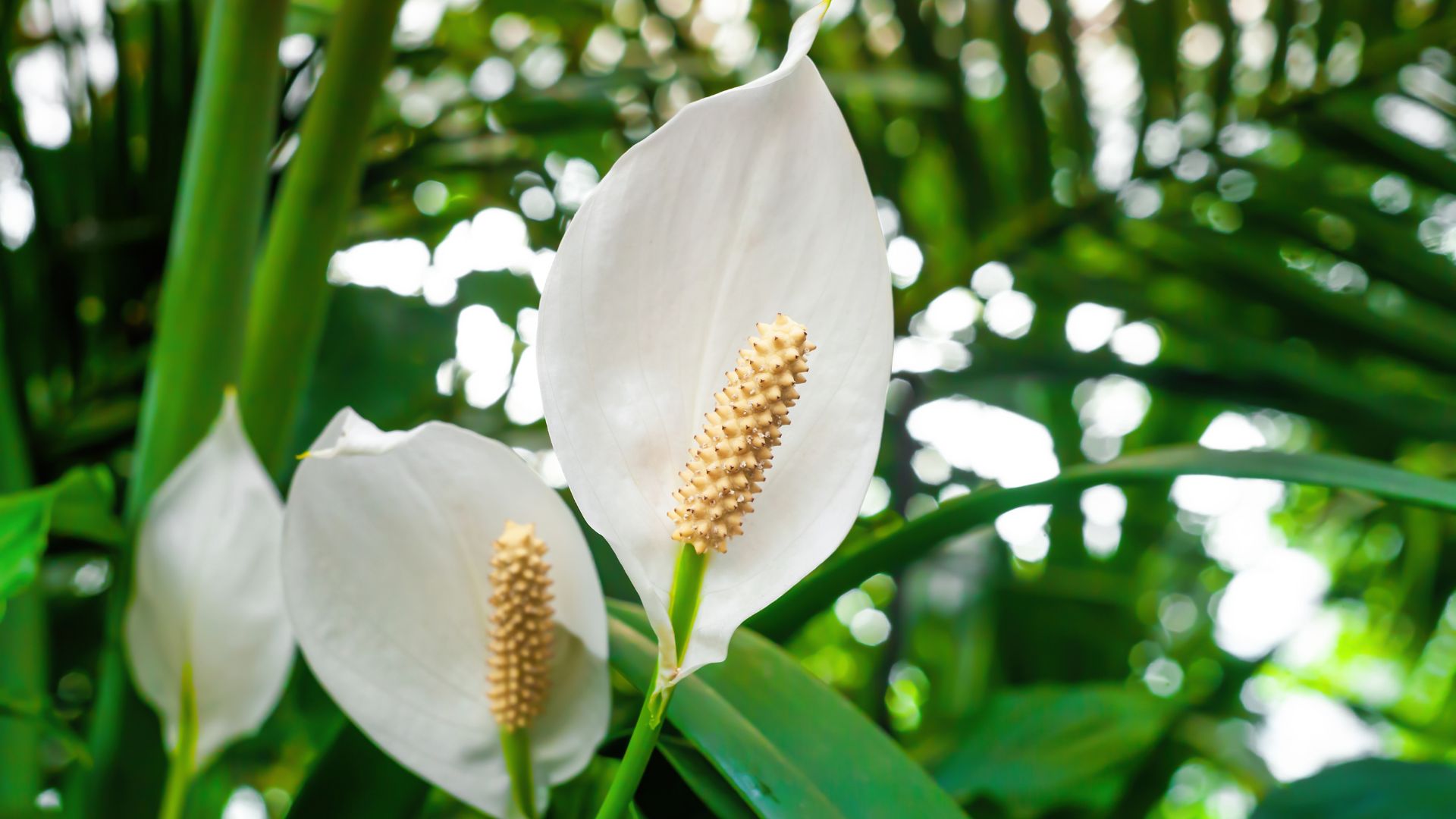
They look like flowers but in actual fact they are leaves
Originating from South America, its mass of dark, glossy leaves and spikes of beautiful white flowers will certainly add a tropical look to your plantscape. The tear-shaped flower isn’t really a flower at all but a ‘spathe’ (Greek for leaf) and this is where the plant gets its botanical name (Spathiphyllum) from. It's the combination of glossy leaves and elegant white flowers that makes this houseplant a timeless classic.
Follow our easy beginner's guide on how to care for a peace lily and find out the ideal growing conditions, avoiding the most common houseplant mistakes. Then you'll be able to keep your precious plant looking beautiful for months to come.

Jo Lambell is the founder of Beards & Daisies, which sells a carefully curated selection of houseplants put together by a team who genuinely live and breathe plants and are RHS Chelsea Flower Show medal winners.
1. Choose the right location for your peace lily
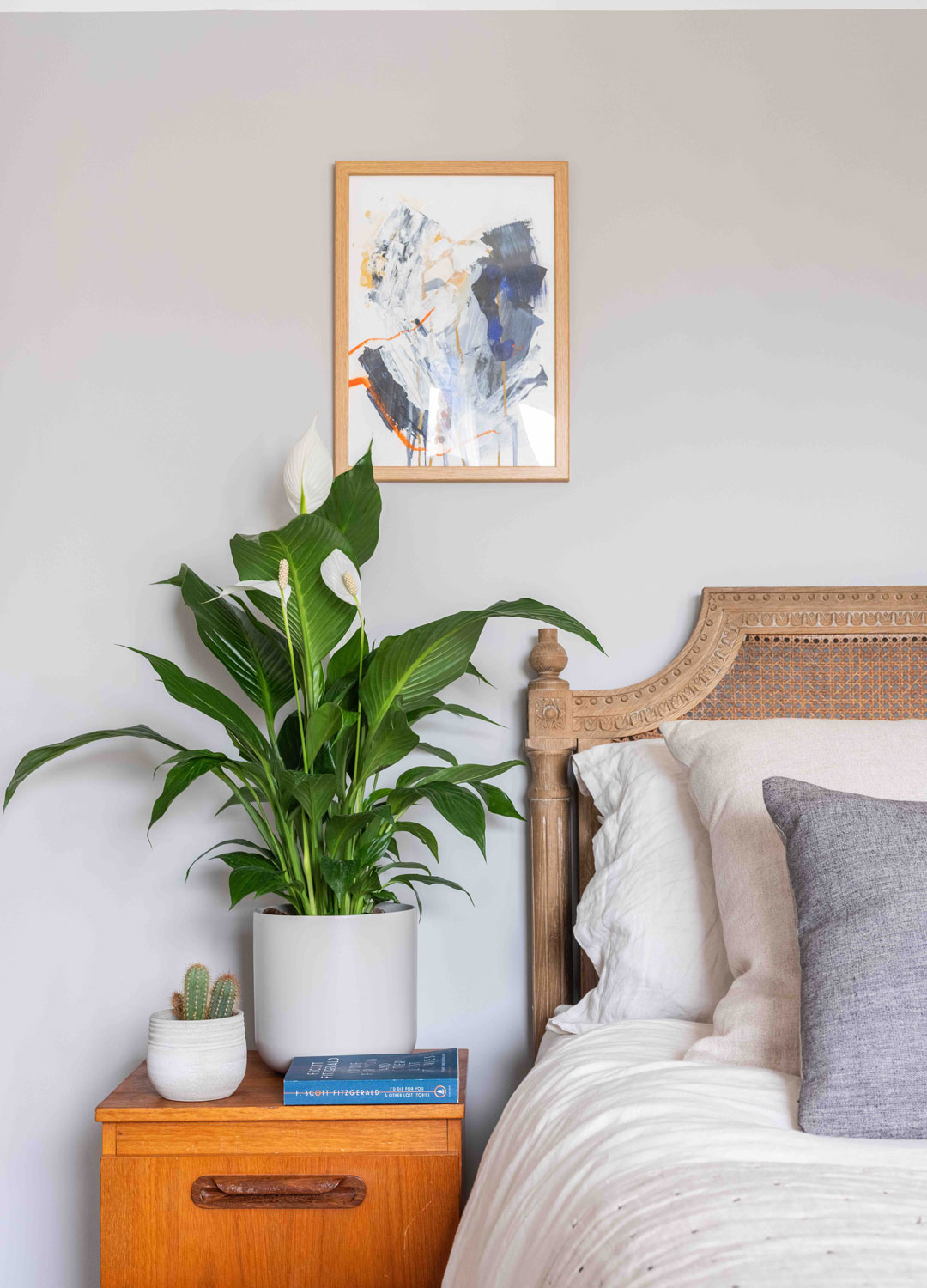
A bedroom with low light is the perfect spot for a peace lily and can purify the air while you sleep
It's best to keep your peace lily out of direct sunlight as it does best in a lightly shaded spot. In fact these plants can withstand very low light levels but this doesn’t necessarily mean it's ideal for them. If you want flowers to bloom they need bright, indirect light. While it can cope with lower light, you may notice your peace lily doesn't flower in these conditions.
An especially important part of how to care for a peace lily is to keep your plant out of direct sun in summer to avoid the leaves getting burnt and scorched, and the flowers drying out. Similar to what causes monstera leaves to turn brown.
Make sure your peace lily is kept at a minimum winter temperature of 10˚C, although it can survive if the temperature drops a little lower. But remember the peace lily comes from the tropics, so make sure you keep it away from draughts and doors to avoid mould on the soil. Generally these plants are trouble-free and require little upkeep, meaning they stay beautiful for years if cared for properly.
2. Get the watering needs right

When watering your peace lily plant treat it to filtered water or rainwater
How often you water any houseplant, particularly the peace lily plant, depends on the indoor temperature and the season. Your plant will soon let you know when it needs watering as the leaves will start drooping.
“You can gauge when to water your peace lily by feeling the top inch of soil, and only water your plant when it has dried out," says Claire Bishop, senior houseplant buyer at Dobbies. "Then, to ensure your plant gets the hydration it needs, consider placing it in a sink or the bath, and giving it a thorough soaking until water runs out of the bottom of the drainage container."
These plants are not keen on tap water, particularly if you live in a heavily chlorinated area, so it’s a good idea to let tap water stand before using it so that the chlorine can evaporate a little.
Alternatively, use rainwater harvesting to collect water in the garden. The Accurate 100 Litre Garden Water Butt Set with stand fro £44.99 from Amazon is a great budget solution to get started.
Top tip: Always use room temperature water to avoid a cold shock for your plant.
Let your peace lily dry out between waterings, but don’t let it get to the stage where the leaves start to wilt. Don’t leave your plant sitting in a saucer of water either as this can lead to the roots rotting. Keep the compost damp all year round and water more often in summer, cutting back to fortnightly during the winter months. If you're wondering why is my peace lily drooping, give it a thorough watering and it will soon revive.
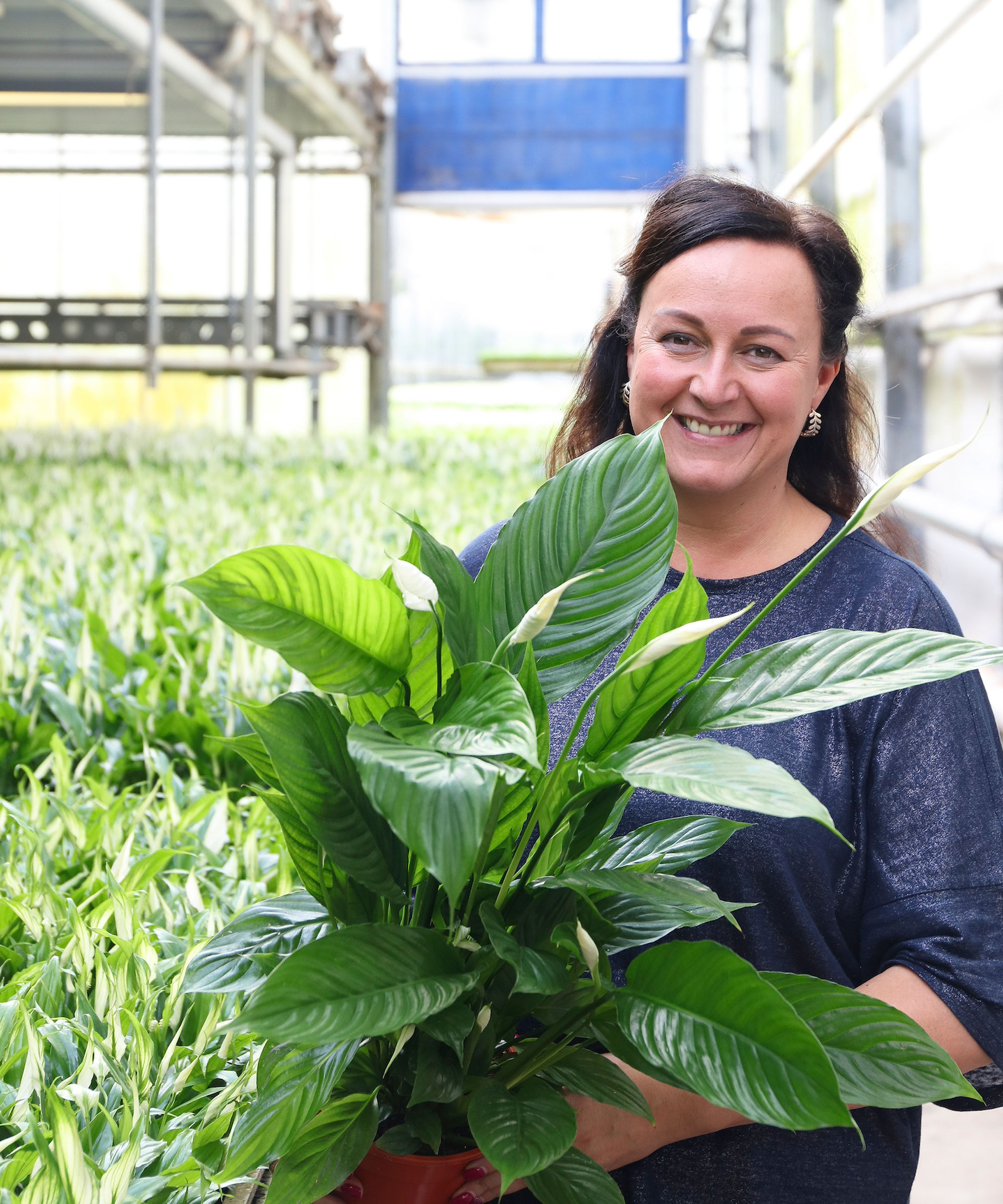
Claire has been part of the Dobbies team for over 12 years, where she is responsible for sourcing and buying houseplants, as well as playing an integral role in the development of @little dobbies, where houseplants make up 70% of the range. For the past seven years, Claire has been on the assessment panel for both the RHS Chelsea Flower Show and Hampton Court Palace Flower Show.
3. Keep conditions humid

A steamy shower feels like the tropical rainforest to humidity-loving peace lilies
Peace lilies are one of the best plants to help with condensation. As they're native to tropical rainforests, peace lilies thrive in high humidity so mist yours regularly or keep it in a bathroom, where all those lush leaves will create the feeling of a spa-like sanctuary. Your plant will enjoy the steamy atmosphere generated by the shower or bath.
"A light-filled bathroom is the perfect spot for most peace lilies as they’ll thrive in the humidity," says Claire Bishop. "However, if you prefer to style your plant elsewhere, a regular misting will keep its leaves glossy and mimic the tropical climate it’s used to.”
Alternatively, mist the leaves regularly to replicate the conditions enjoyed by your plant and it will return the favour by growing lots of lush leaves. Putting a tray with moistened gravel underneath your peace plant will also help boost humidity levels.
4. When to feed your plant

Fertilizer is not really a top priority for peace lily plants
The peace lily is not a demanding plant when it comes to food. In fact, over-fertilising could harm it by burning the roots. Another key part of how to care for a peace lily is never applying fertiliser to dry soil, as this may also scorch the roots. However, this doesn't mean your plant won't benefit from a little boost now and then.
"Peace lily plants will appreciate being fed once a month with a balanced houseplant food throughout the growing season, from spring to late summer, after which they go into dormancy and stop putting on growth," says Kelly Dryer, plant doctor at Patch Plants.
Try the quirky Miracle-Gro 1002522 Indoor Plant Food Spikes from Amazon to take the hardworking out of feeding your plant. Alternatively, following how to use banana peel in the garden you can make a nutrient-rich liquid fertiliser to water your indoor plants too.
If you feed your plant more often, for example, because it has lots of flowers, use a very diluted fertiliser as overfeeding can cause brown spots on the leaves or the flowers themselves to turn a mix of green and white instead of pure white.

An RHS-trained horticulturist, Kelly has honed her skills through almost a decade of study and work, and is a key part of the team at Patch Plants. She has hands-on experience as a head gardener, glasshouse gardener and freelance garden designer.
5. Keep your plant looking good
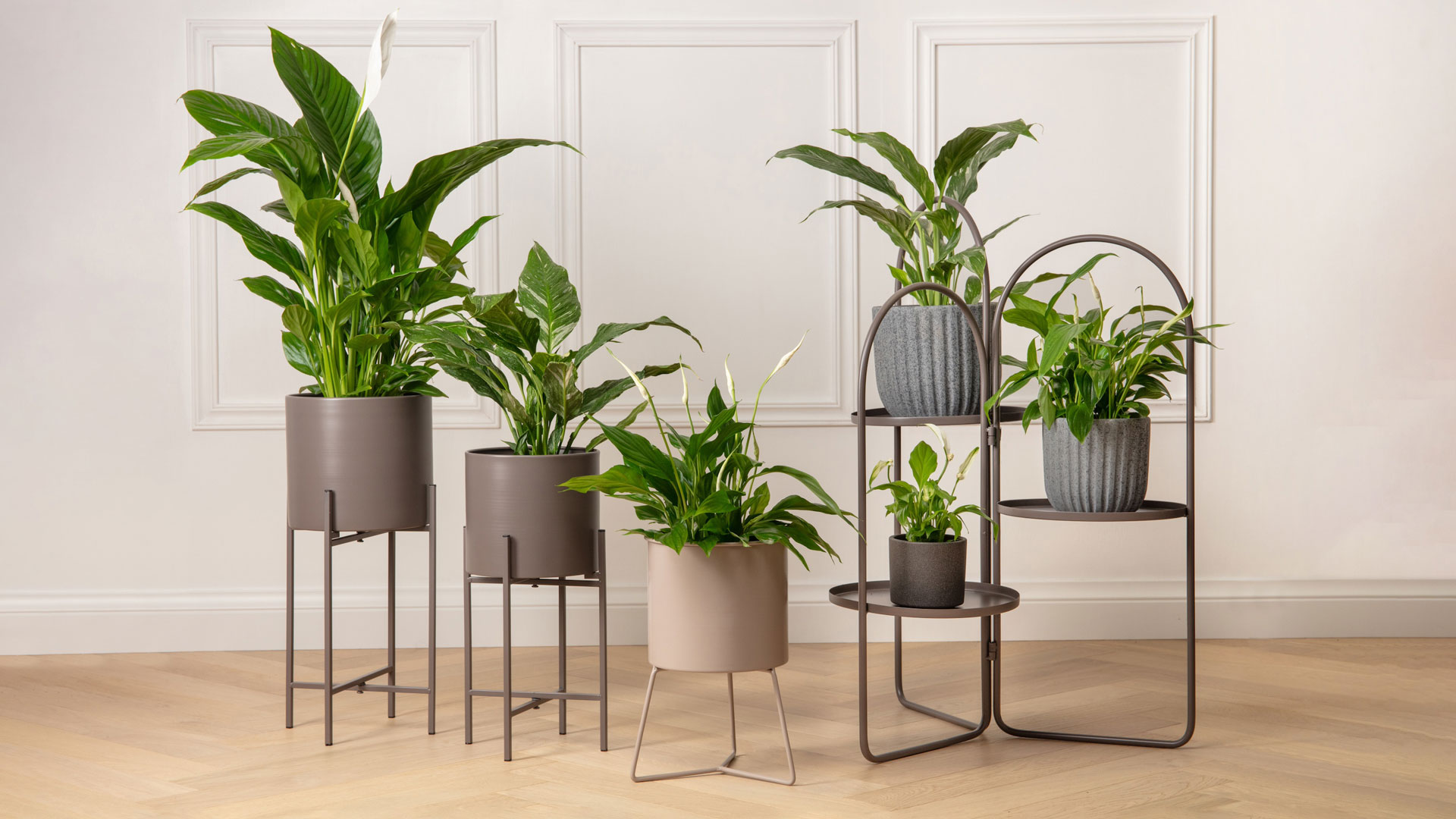
Don't forget to dust the leaves of peace lilies to keep them glossy
Find out how to clean plant leaves as it's important to regularly dust leaves or gently wipe them with a damp cloth as a build-up of dust stops your plant getting enought light to photosynthesise properly. "Wiping your peace lily plant's leaves is all the TLC it needs for leaves to stay glossy," says Kelly Dryer. "Keep it healthy and dust free by using a damp cloth to stroke the foliage clean or alternatively give your plant a gentle shower with warm water to keep it shining."
If the leaves aren't looking their usual glossy self check the undersides for any pests. Peace lily plants rarely suffer from invaders but this is where you'll find any bugs if there is a problem.
“If you find pests on your peace lily, it’s important that you treat the problem straight away”, advises Claire Bishop. “Using a damp cloth, wipe away as many of the pests as possible and cut back any affected spathes or leaves, making sure to pay close attention to the underside of the plant."
Then, in either a sink or using an outdoor hose, carefully rinse the entire plant with water to remove any pests that have been missed. You should repeat these steps every few days until all signs of pests are gone, and until then, quarantine your plant in a room away from all other houseplants to prevent the pests spreading.
Another key part of how to care for a peace lily is deadheading faded flowers. Cut them off regularly and more flowers will grow.
6. Repot when necessary
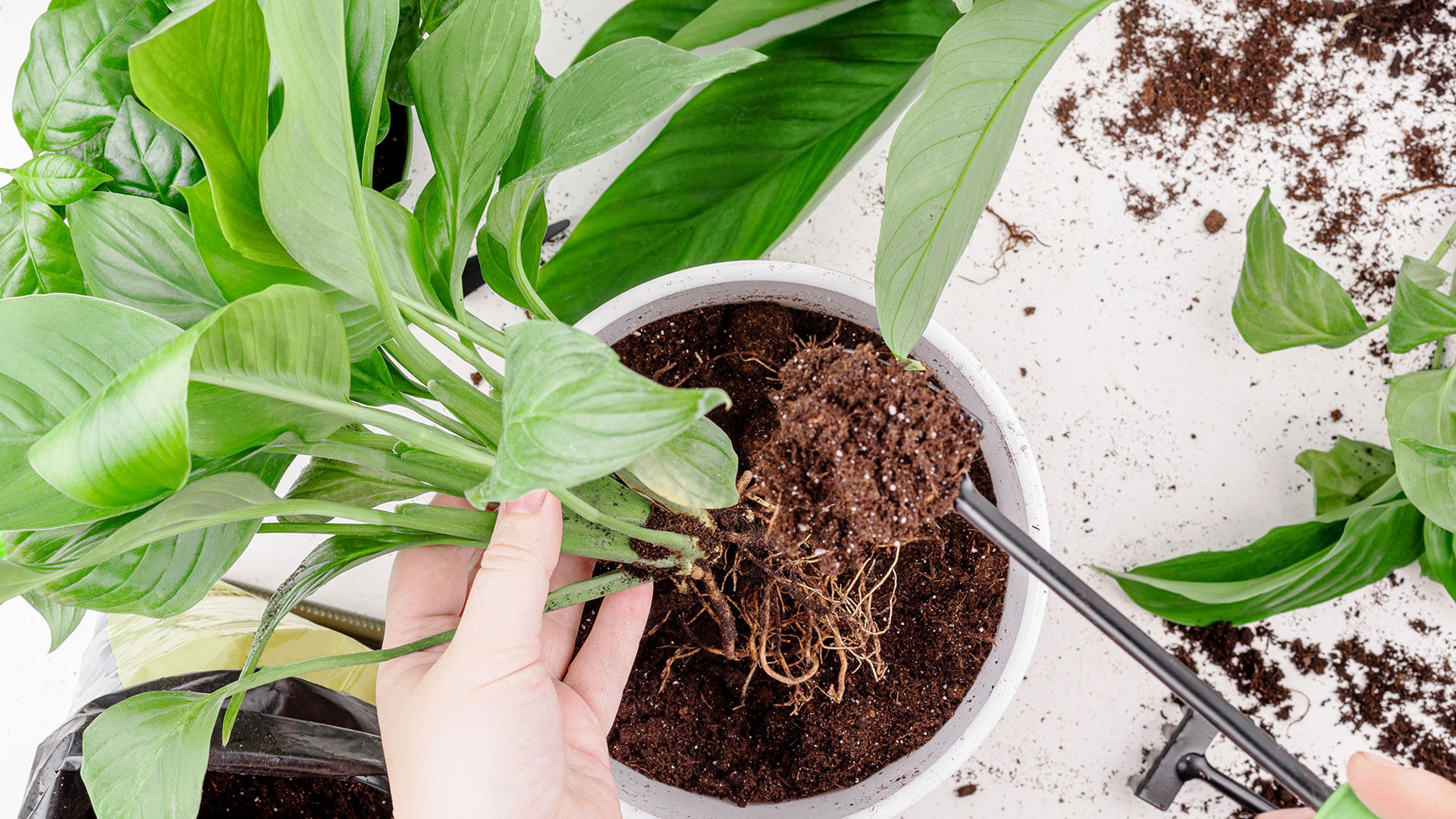
When you repot your peace lily you'll see it naturally divides into leafy little clumps that can easily be propagated into new plants
The peace lily grows quickly and makes a lovely bushy plant. If your plant is thriving and the roots are beginning to grow through the holes at the bottom of the pot it's time to repot your plant. It's also a great time to make some babies to grow your plant collection.
Spring is the best time to repot your plant, using fresh, well-draining, multi-purpose compost. "Choose a plastic pot 1-2 sizes bigger than the existing one to give your plant room to grow," says Kelly Dryer.
"Peace lilies can be split into multiple plants by dividing the clump, ensuring each new plant has some good strong roots to grow from. They may take some time to adjust to their new home, so don’t panic if they stop flowering for a while."
Keep an eye on repotted plants, misting the foliage regularly, and making sure the compost doesn't dry out, and soon you will have quite a collection.
FAQS
How do you take care of an indoor peace lily?
Take care of an indoor peace lily by ensuring it gets the right growing conditions to thrive. Remember in their natural rainforest home they receive dappled sunlight and consistent moisture, so aim to replicate these conditions for your plant to be healthy and happy.
One of the remarkable characteristics of peace lilies is their ability to flower almost continuously throughout the year, even in low-light conditions. They can handle most light levels but prefer a spot out of direct sunlight.
Peace lilies are low-maintenance plants, not one of the easiest plants to keep alive but also not one of the hardest houseplants to keep alive, requiring watering only when the soil feels slightly dry. They're not very demanding when it comes to fertiliser either, requiring a feed just once a month during the growing season.
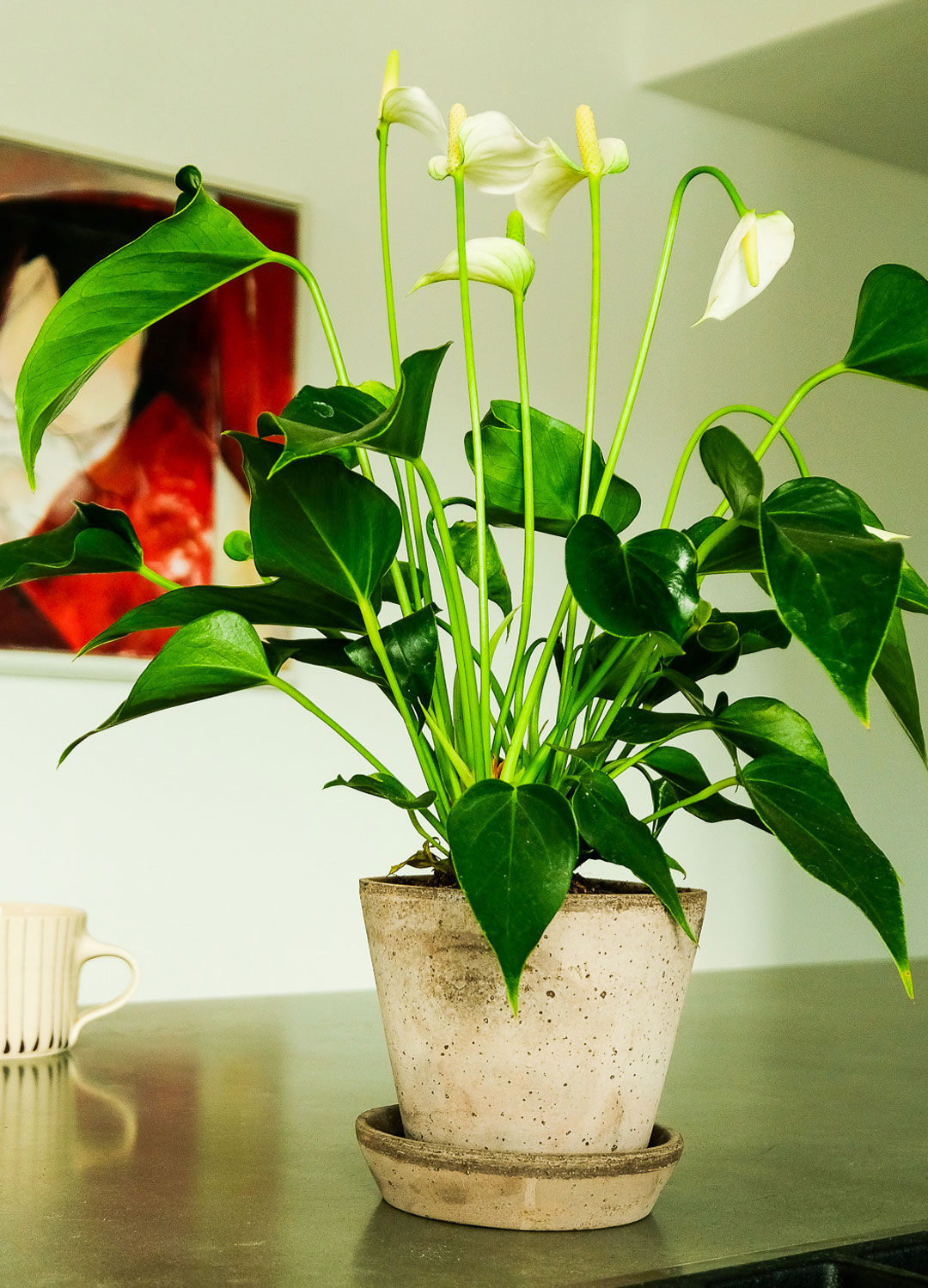
A peace lily looks good on a kitchen counter and will thrive as long as the room isn't too bright
How often must I water a peace lily?
"Peace lilies enjoy a humid atmosphere so ideally pop them in a steamy bathroom or kitchen," says Kelly Dryer. "Grouping them together with other plants can also create a humid microclimate. Lightly water them when the top two inches of their soil feels dry and keep them consistently moist."
Being left to dry out completely and then dousing them with water will only stress plants, so establishing a regular watering regime is the key to success when learning how to care for a peace lily.
How do I know if my peace lily is happy?
"A happy peace lily will have dark green, glossy leaves, and it may produce white blooms periodically," says Jess, one of the houseplant experts at The Glasshouse. "If the plant is thriving, it will maintain its overall appearance without yellowing or browning leaves.
Additionally, the plant will continue growing new leaves, indicating its health and vitality. The leaves of the plant will usually droop if it requires watering, but will perk up very quickly afterwards."
How about if your plant is unhappy? "A peace lily will let you know when it's unhappy," says Kelly Dryer. "The leaves will flop and look very wilted and sad. This is usually a sign that it needs water but it can also be a sign of overwatering so be sure that the soil is dry before giving it a drink. The trick is to keep your soil consistently and lightly moist."
If your plant doesn't recover even after watering, you can cut the foliage right down to above soil level and it will send up nice new growth in no time, so don't give up on your plant.
Peace lily leaves turning yellow or brown suggest your peace lily has been exposed to too much light. Some yellow peace lily leaves are normal, so simply remove them to make room for fresh leaf growth. Overwatering may also lead to yellowing of the leaves, so let the soil dry out a bit and see if there's any improvement. Brown edges on the leaves could indicate that your peace lily is getting too much direct sunlight. Simply move the plant to somewhere more shaded.
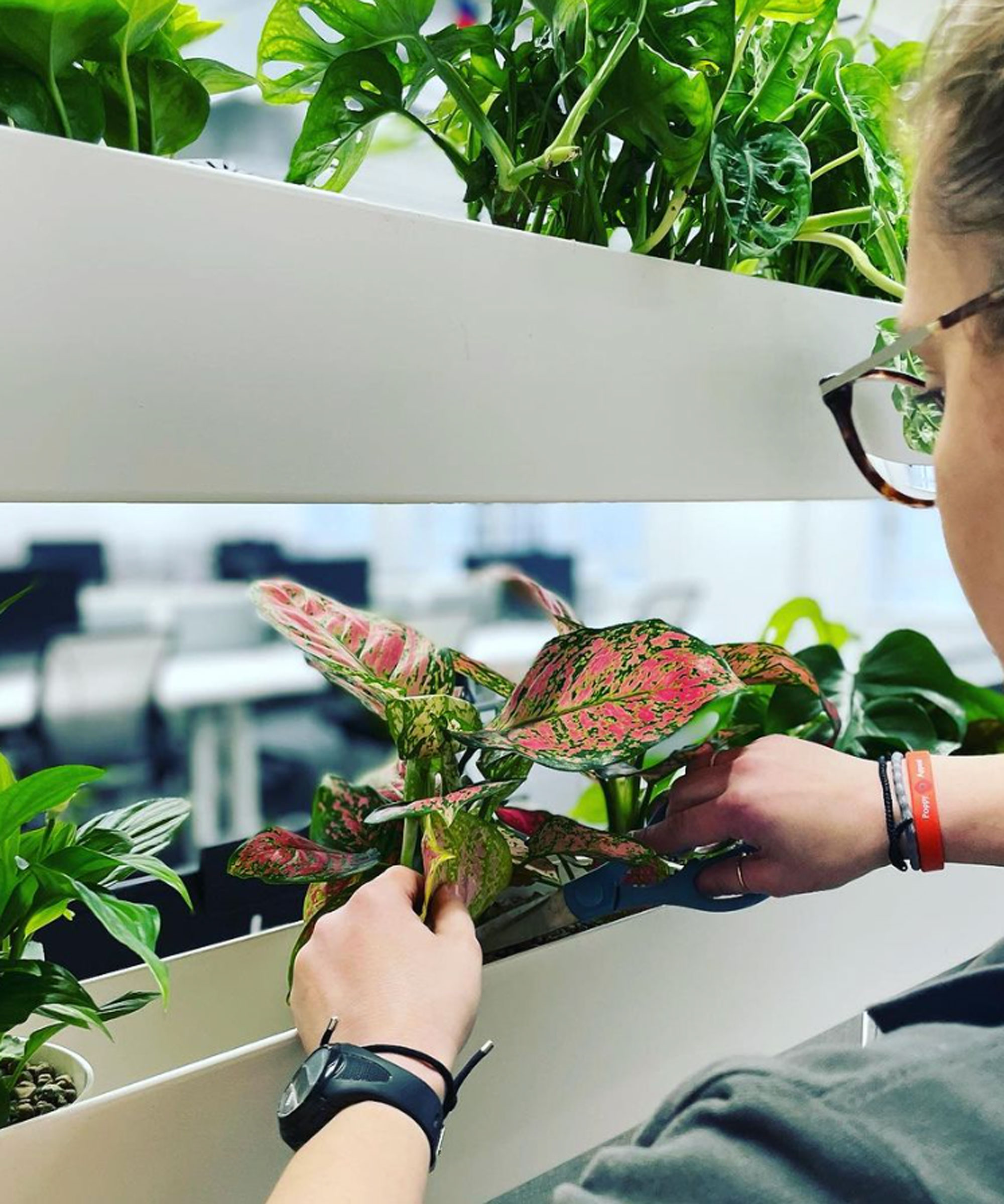
Jess is a plant expert at The Glasshouse, a social enterprise offering second chances to women prisoners reaching the end of their prison sentence. Their mission is to reduce reoffending through horticultural training and employment. Their team grow and nurture beautiful, resilient houseplants, which are sold directly through their website and shop located in Cranbrook, Kent.
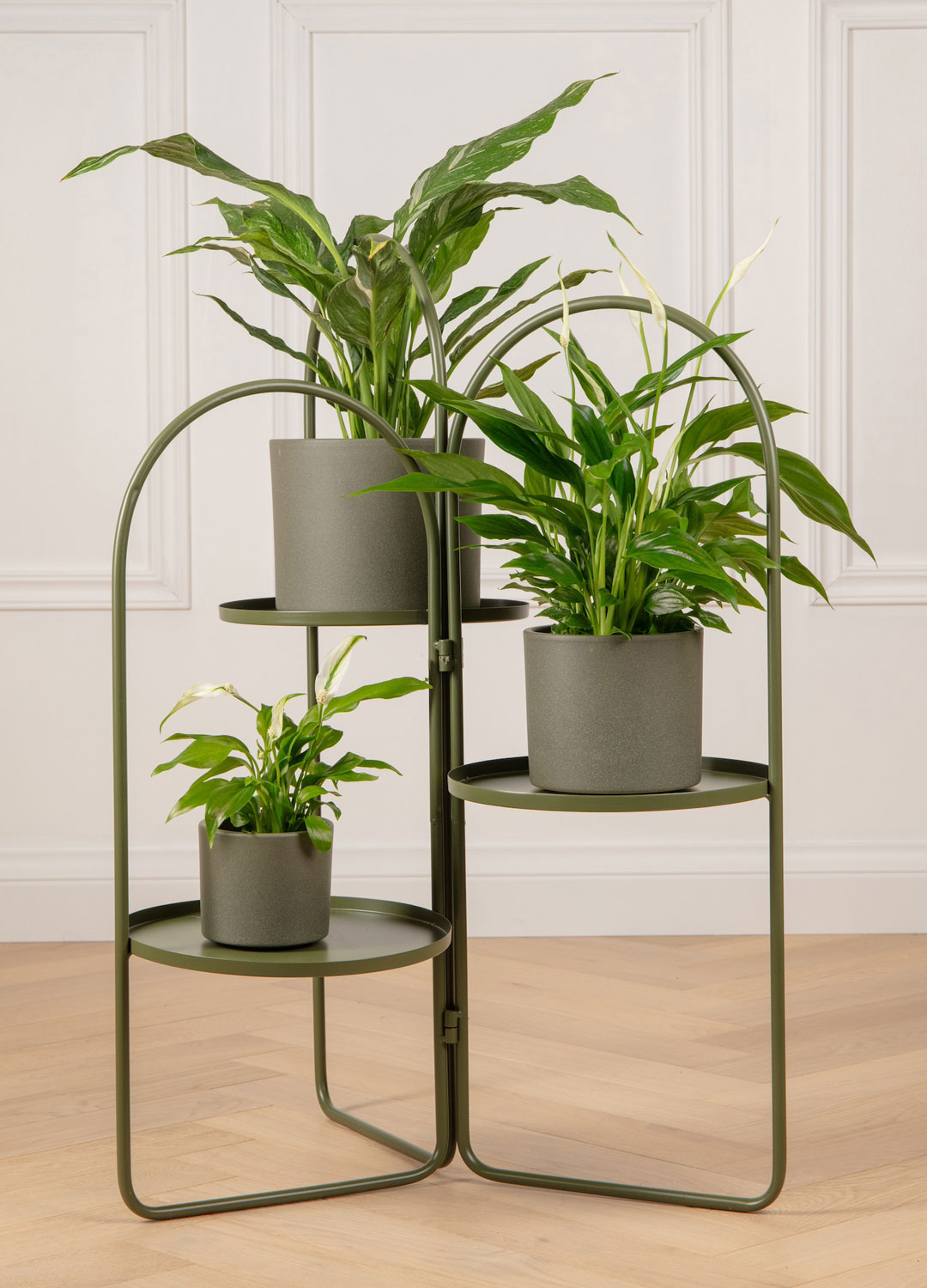
Happy plants have lots of lush leaves and flower regularly
How long do peace lilies live?
How long a peace lily lives depends on the care you give it and the environment you put it in. Many people consider three to five years an average peace lily lifespan. However, indoor peace lilies have been known to live two decades or more.
"Like most houseplants, peace lilies can live for many years with proper care," says Jess. "On average, they can live for 5 to 10 years, but with optimal conditions and care, they have been known to live even longer, sometimes up to 15 years or more."
Finding out how to look after a peace lily is easy if you remember these easy pointers provided by the experts who know best.
Remember also that the peace lily is one of the most common houseplants that is toxic to cats – one to avoid if you have inquisitive pets.
Lifestyle journalist Sarah Wilson writes about flowers, plants, garden design and trends. She has studied introductory garden and landscape design and floristry, and also has an RHS Level 2 qualification in the Principles of Plant Growth and Development. In addition to homesandgardens.com and livingetc.com she's written for gardeningetc.com, Real Homes, Modern Gardens and Country Homes & Interiors magazines. Her first job was at Elle magazine, during which time a trip to the beautiful La Colombe d'Or in St-Paul-de-Vence led to an interest in writing about all things botanical. Later as lifestyle editor at Country Homes & Interiors magazine the real pull was the run of captivating country gardens that were featured.
